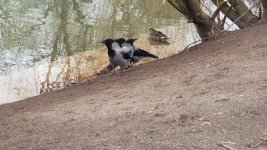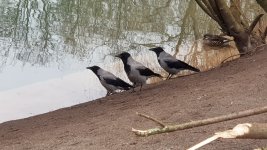
Habitat: meadows with bushes, a forest and human settlements nearby.
1. A Barbary dove (not a feral pigeon on head and bill shape?).
2. A(n unidentifiable?) brown finch (twite: conspicuous white wing bars, darker upperparts, small beak, more deeply forked tail, bulk; linnet: time of the year, no obvious yellow on the beak (the vague purplish cast to the front is just an artifact, I'm afraid)).
3. A female sparrowhawk. (Despite having read about it in a few threads, I still don't get the wing formula thing. I do, however, notice sharp tail corners, a small head and, perhaps, a less bulky shape overall. What's more, it is noticeably larger than the hooded crow flying next to it, which would make it a female? Unfortunately, it's still all guesswork for me. By the way, how do I know if it's mobbing behaviour on behalf of the crow or not?)
1. A Barbary dove (not a feral pigeon on head and bill shape?).
2. A(n unidentifiable?) brown finch (twite: conspicuous white wing bars, darker upperparts, small beak, more deeply forked tail, bulk; linnet: time of the year, no obvious yellow on the beak (the vague purplish cast to the front is just an artifact, I'm afraid)).
3. A female sparrowhawk. (Despite having read about it in a few threads, I still don't get the wing formula thing. I do, however, notice sharp tail corners, a small head and, perhaps, a less bulky shape overall. What's more, it is noticeably larger than the hooded crow flying next to it, which would make it a female? Unfortunately, it's still all guesswork for me. By the way, how do I know if it's mobbing behaviour on behalf of the crow or not?)
Attachments
-
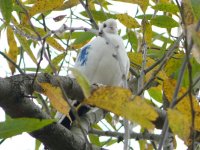 1.1 (Barbary dove).JPG1.5 MB · Views: 193
1.1 (Barbary dove).JPG1.5 MB · Views: 193 -
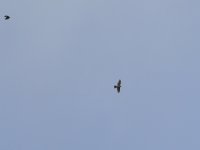 3.9 (sparrowhawk).JPG975 KB · Views: 198
3.9 (sparrowhawk).JPG975 KB · Views: 198 -
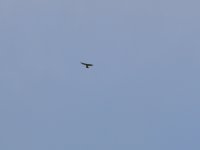 3.8 (sparrowhawk).JPG973.1 KB · Views: 178
3.8 (sparrowhawk).JPG973.1 KB · Views: 178 -
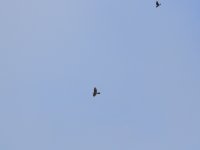 3.7 (sparrowhawk).JPG956.1 KB · Views: 174
3.7 (sparrowhawk).JPG956.1 KB · Views: 174 -
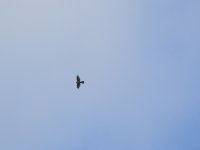 3.6 (sparrowhawk).JPG991.3 KB · Views: 175
3.6 (sparrowhawk).JPG991.3 KB · Views: 175 -
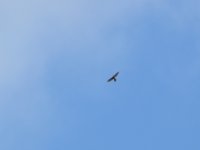 3.5 (sparrowhawk).JPG984.6 KB · Views: 174
3.5 (sparrowhawk).JPG984.6 KB · Views: 174 -
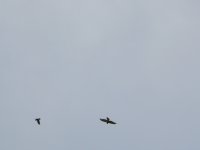 3.4 (sparrowhawk).JPG1 MB · Views: 167
3.4 (sparrowhawk).JPG1 MB · Views: 167 -
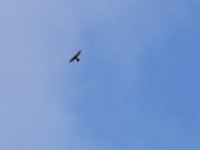 3.3 (sparrowhawk).JPG999.9 KB · Views: 188
3.3 (sparrowhawk).JPG999.9 KB · Views: 188 -
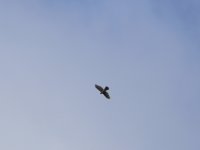 3.2 (sparrowhawk).JPG983.5 KB · Views: 191
3.2 (sparrowhawk).JPG983.5 KB · Views: 191 -
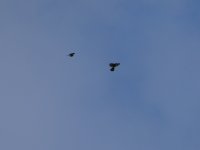 3.1 (sparrowhawk).JPG1.1 MB · Views: 208
3.1 (sparrowhawk).JPG1.1 MB · Views: 208 -
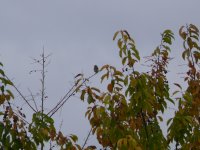 2 (finch).JPG1.4 MB · Views: 191
2 (finch).JPG1.4 MB · Views: 191 -
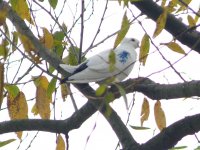 1.3 (Barbary dove).JPG1.3 MB · Views: 165
1.3 (Barbary dove).JPG1.3 MB · Views: 165 -
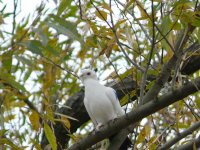 1.2 (Barbary dove).JPG1.5 MB · Views: 156
1.2 (Barbary dove).JPG1.5 MB · Views: 156
Last edited:




